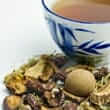Background
- Sarsaparilla (Smilax species) is a vine with prickly stems, shiny leaves, and numerous reddish-brown roots. Among several recognized sarsaparilla species, Jamaican Smilax regelii (also known as Smilax officinalis) is the most commonly cultivated for commercial and medicinal use.
- Sarsaparilla is used as a flavoring for beverages and as a homeopathic medicine. It is also used in traditional Chinese medicine to treat a variety of diseases. Compounds extracted from the rhizomes, or horizontal underground stems, and fruit are being explored as potential treatments for cancer, arthritis, human immunodeficiency virus (HIV), and various inflammatory conditions. A combination of Nigella sativa seeds, Hemidesmus indicus root, and Smilax glabra rhizome is used by traditional medical practitioners in Sri Lanka to treat cancer.
References
- Bucci LR. Selected herbals and human exercise performance. Am J Clin Nutr 2000;72(2 Suppl):624S-636S. View Abstract
- Caceres A, Lopez BR, Giron MA, et al. Plants used in Guatemala for the treatment of dermatophytic infections. 1. Screening for antimycotic activity of 44 plant extracts. J Ethnopharmacol 1991;31(3):263-276. View Abstract
- Cai Y, Chen T, Xu Q. Astilbin suppresses collagen-induced arthritis via the dysfunction of lymphocytes. Inflamm Res 2003;52(8):334-340. View Abstract
- Chu KT, Ng TB. Smilaxin, a novel protein with immunostimulatory, antiproliferative, and HIV-1-reverse transcriptase inhibitory activities from fresh Smilax glabra rhizomes. Biochem Biophys Res Commun 2006;340(1):118-124. View Abstract
- Grunewald KK, Bailey RS. Commercially marketed supplements for bodybuilding athletes. Sports Med 1993;15(2):90-103. View Abstract
- Guo J, Qian F, Li J, et al. Identification of a new metabolite of astilbin, 3'-O-methylastilbin, and its immunosuppressive activity against contact dermatitis. Clin Chem 2007;53(3):465-471. View Abstract
- Hsu S. Green tea and the skin. J Am Acad Dermatol 2005;52(6):1049-1059. View Abstract
- Huang YG, Li QZ, Ivanochko G, et al. Novel selective cytotoxicity of wild sarsaparilla rhizome extract. J Pharm Pharmacol 2006;58(10):1399-1403. View Abstract
- Ji W, Zhu XX, Tan WF, et al. Effects of Rebixiao granules on blood uric acid in patients with repeatedly attacking acute gouty arthritis. Chin J Integr Med 2005;11(1):15-21. View Abstract
- Liu XR, Han WQ, Sun DR. [Treatment of intestinal metaplasia and atypical hyperplasia of gastric mucosa with xiao wei yan powder]. Zhongguo Zhong Xi Yi Jie He Za Zhi 1992;12(10):602-3, 580. View Abstract
- Navarro MC, Montilla MP, Cabo MM, et al. Antibacterial, antiprotozoal and antioxidant activity of five plants used in Izabal for infectious diseases. Phytother Res 2003;17(4):325-329. View Abstract
- Sautour M, Miyamoto T, Lacaille-Dubois MA. Steroidal saponins from Smilax medica and their antifungal activity. J Nat Prod 2005;68(10):1489-1493. View Abstract
- Thabrew MI, Mitry RR, Morsy MA, et al. Cytotoxic effects of a decoction of Nigella sativa, Hemidesmus indicus and Smilax glabra on human hepatoma HepG2 cells. Life Sci 2005;77(12):1319-1330. View Abstract
- Wang J, Li Q, Ivanochko G, et al. Anticancer effect of extracts from a North American medicinal plant--wild sarsaparilla. Anticancer Res 2006;26(3A):2157-2164. View Abstract
- Yip EC, Liu AM, Wong JT, et al. An aqueous extract of the popular Chinese nutraceutical Kwei Ling Ko (Tortoise shell-Rhizome jelly) activates the PPARgamma pathway and down-regulates the NFkappaB activity. Phytomedicine 2005;12(10):748-759. View Abstract







